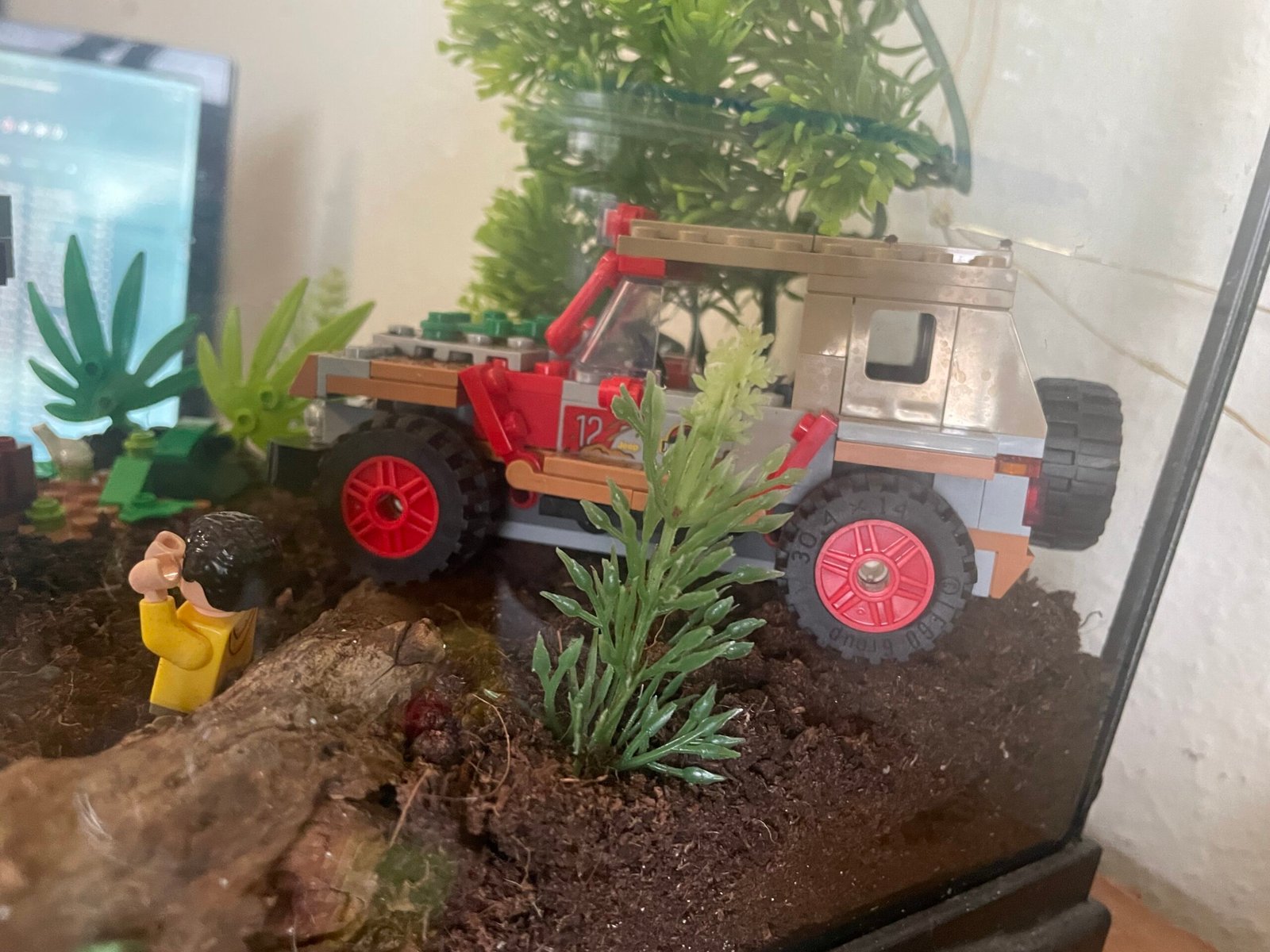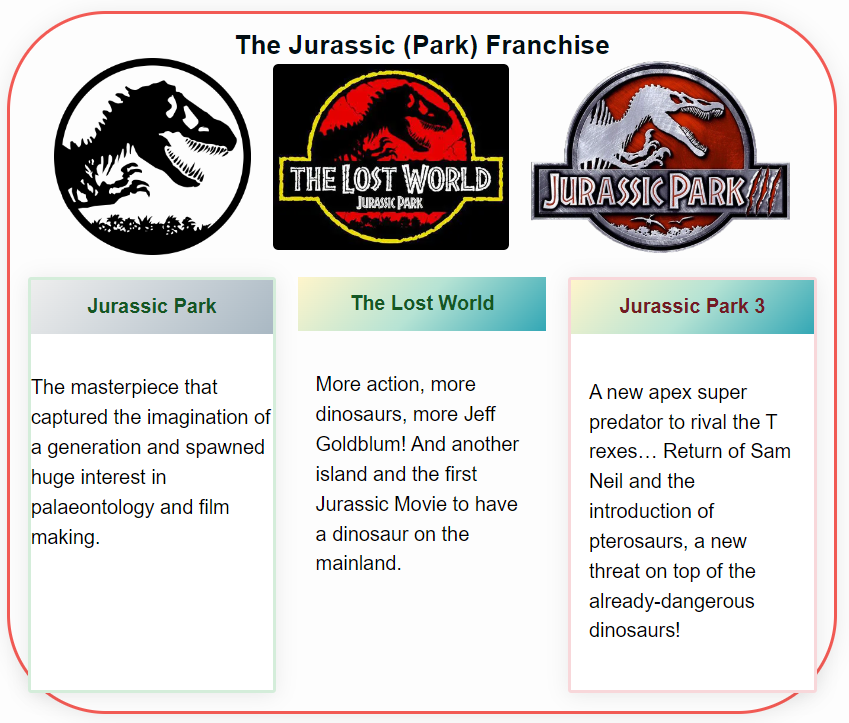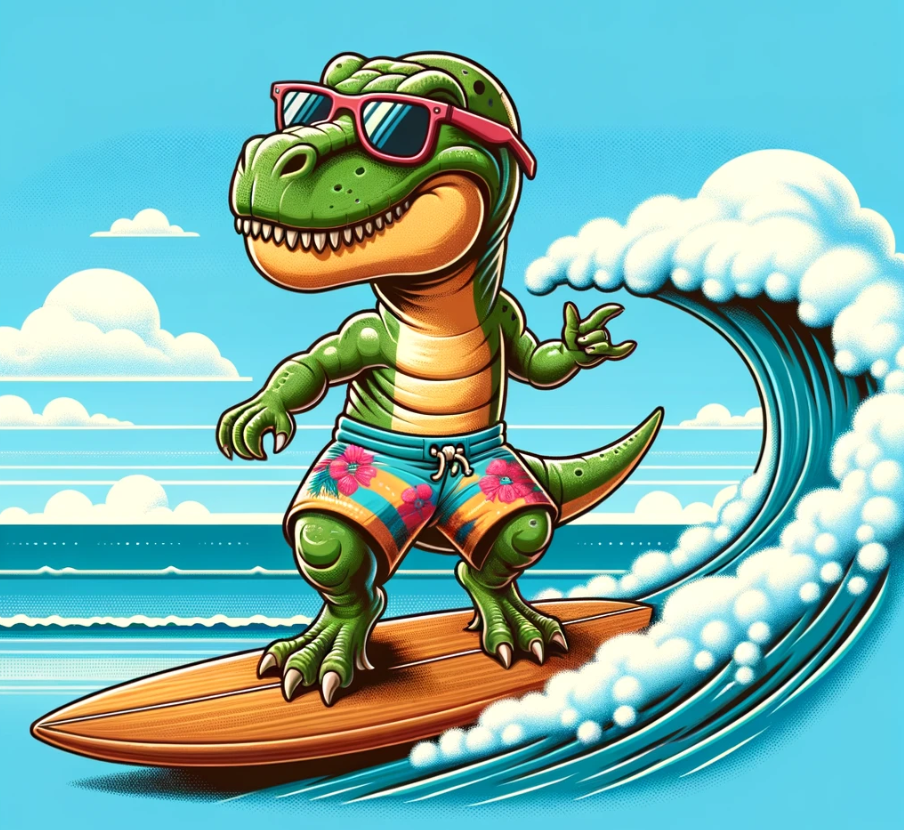Watching Jurassic Park as a kid, this dinosaur was my favourite for a long, long time. The raptors and T rex were very cool, but the colours were similar (and bland). The herbivores were cool but
Putting aside the raptor’s intelligence and sickle claws, the kid version of me found the predatory dinosaurs pretty much small and large versions of eachother…
Enter the Dilophosaurus.
This was something else. It obviously had some intelligence about it, just like the Velociraptors, but it had more of an arsenal up its sleeve…or frill.
This dinosaur was smart enough to lure its prey – in this case the saboteur Dennis Nedry – into a false sense of security and then dazzle him with a large, colourful frill and an almighty hiss, confusing its prey before spitting venom at him.
It was a surprising addition to just claws, teeth and sheer size.
Did You Know? Dilophosaurus was one of the few original Jurassic Park species that was actually from the Jurassic Period? They lived around 186 million years ago.
Now as a child I had some Jurassic Park toys and figures but never really “set pieces” as such.
So when LEGO released their JP 30th Anniversary sets, I was stoked.
The first one I brought was the Dilophosaurus and Dennis Nedry set. It just so happened to be around the time I brought home a baby Ghost Mantis, so I was preparing to make a new enclosure for this real-life savage beast (who right now is around the size of a fingernail, but savage nonetheless.
With limited space and having kids with their own LEGO interests, I thought I’d kill two birds with one stone. See below:

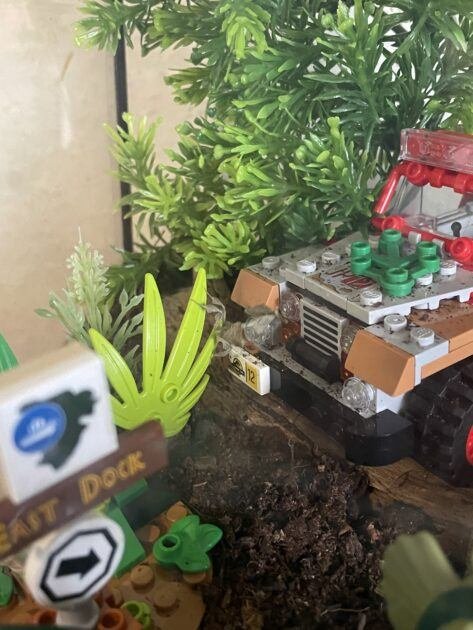

Having just enough space to fit the whole LEGO set in, with some foliage in the background, I managed to recreate the scene with the Jeep up on the hill, the East Dock sign to the side and the pair of figures in the foreground, with Dennis Nedry about to meet his demise.
I had to include the Barbosol can right at the front, partially buried just to give it that finishing touch.
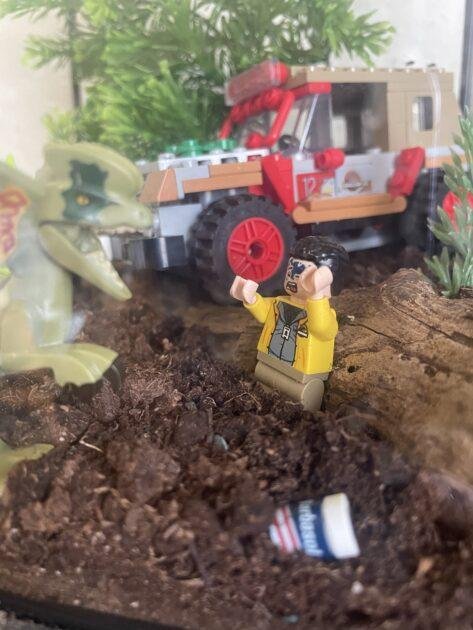
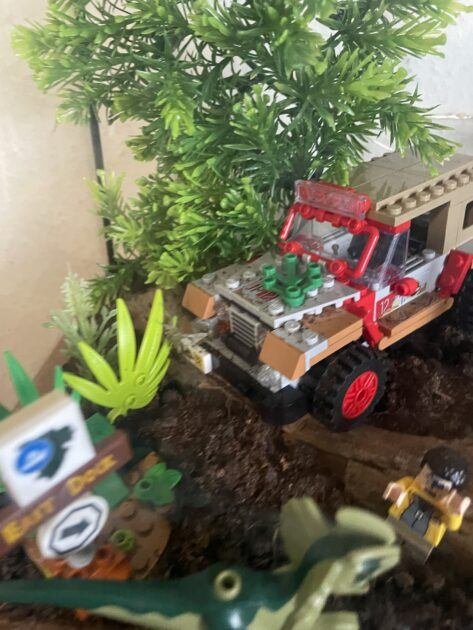
Before anybody jumps in about this not being a suitable enclosure for a mantis, the tank is designed as an invertebrate terrarium with glass sides and a secure mesh lid. As the mantis grows it will likely go into one of my taller enclosures with more foliage. So far he’s loving the increased space and climbing surfaces compared to the little tub he came in!
Wondering What’s in the LEGO Set? Here are the Details
LEGO 76958 Jurassic Park Dilophosaurus Ambush “30th Anniversary Collection”
I will admit I was expecting a more adult or grown up version of the LEGO 30th Anniversary sets but I was more than happy to be able to incorporate both one of my favourite Jurassic Park scenes and favourite dinosaurs into a custom enclosure.
But I think the bigger sets such as T rex Breakout or the Brachiosaurus set will have to be placed on a shelf on full display and not set in dirt…
Since I like to dive deep into my obsessions, here’s some more cool stuff on this early Jurassic dinosaur:
Jurassic Park Novel Dilophosaurus vs Jurassic Park Movie Dilophosaurus
Although both versions of the Dilophosaurus in the movie and book have the two crests, frill and ability to spit venom, there are some differences.
The novel Dilophosaurus is larger, at 10 feet tall and its colouring is different to the movie
Novel Dilophosaurus
- 10 foot tall (still smaller than the real dinosaur)
- Crests are red with black stripes
- Leopard style colouring – yellow with black spots
- Light green underside
- No frill
Movie Dilophosaurus
- Smaller than novel counterpart, at less than 6 foot high (though may have been a juvenile)
- Dark green body with red, yellow and black stripes
- Large, colourful and rattling extendable frill around neck
Some similarities are that they can vocalise “hooting” sounds like an owl to communicate or entice unwary prey, and both spit venom. They also both have the distinctive double crests on their heads, just like the real life Dilophosaurus.
And both versions kill Dennis Nedry.
On that note, what did the Dilophosaurus actually do to Nedry?
Although in broad strokes, the Dennis Nedry death scene plays out the same way, there are key differences between the movie and novel.
Nedry’s Death in the Jurassic Park Novel

You’re probably more familiar with this version of Dennis Nedry’s death, it was arguably deserved and showed this dinosaur’s unique deadly talents.
Nedry ends up getting his Jeep stuck and as he tries to attach the vehicle’s winch to a nearby tree to pull itself free, he hears and then sees the dinosaur but doesn’t appreciate the danger he is in. After appearing to be harmless and “cute,” the Dilophosaurus stalks closer to its target, dazzles and confuses him with its colourful frill, which appears to rattle, and hisses loudly.
Whilst confused and bewildered, especially without his glasses, Nedry finds sticky fluid on his coat, quickly followed by the venom in his eyes.
At this point he panics and tries to escape back into the Jeep but the cunning predator is already there to finish him off (as a kid I was never sure if this was a second Dilophosaurus that attacks him in the Jeep or the same one).
Nedry’s Death in the Jurassic Park Movie
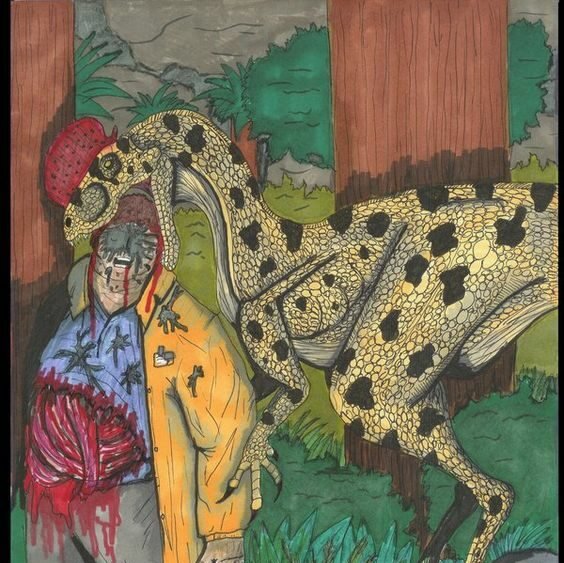
This version of Nedry’s death was far more gory and horrifying than the movie, partly because imagination helps when reading but mostly due to graphic detail and Nedry’s realisation of his own demise *whilst dying.*
As you can tell from the art (found on Pinterest), it’s a very painful and drawn-out death.
The scenario is similar to the movie, except where the movie carefully leaves some detail to the imagination to keep its family friendly (mostly) appeal, you really get an insight into the death in the novel.
Essentially, the Dilophosaurus spits venom at Nedry’s chest and neck, then eyes, blinding him.
Next…it attacks and he ends up holding his intestines, then fully understanding the dire situation before the Dilophosaurus, 10 foot tall in the novel, clamps its jaws around Nedry’s entire head. He has enough time to wish it was over before he actually dies.
Another aspect us Jurassic fans like to do is compare the fictional Jurassic Park species to their real life counterparts, so guess what’s next…
Jurassic Park Dilophosaurus vs Real Dilophosaurus
Dilophosaurus is a genus of theropod dinosaur that lived in the Early Jurassic period, around 193 million years ago. It is known for its distinctive double crests on its skull, which gave it its name, and for its large size and fearsome appearance.
However, the Dilophosaurus depicted in the movie Jurassic Park is quite different from the real Dilophosaurus.
But you’re likely not surprised by this. There is no evidence of frills or venom, especially as this is not the kind of stuff that preserves very well. You could argue that something like a frill will have muscle attachments which in turn will show on the skeleton but in this case, the Author Michael Chrichton and Director Stephen Spielberg took creative liberties to flesh out a more interesting take on this particular dinosaur.
It’s entirely possible other species, known or yet to be discovered, had weird and wonderful adaptations that we may never know about.
Size of Dilophosaurus
The real Dilophosaurus was much larger than its movie counterpart. It was about 20 feet long and weighed up to 1,000 pounds, while the Jurassic Park Dilophosaurus was only about 6 feet long and weighed around 100 pounds.
Skull and Jaw Shape of Dilophosaurus
The real Dilophosaurus had a long, narrow skull with sharp teeth and powerful jaws, designed to bite and tear flesh. Its skull was not equipped with the retractable frills and venom-spitting glands that were added to the Jurassic Park Dilophosaurus for dramatic effect.
Fictional Features Compared to Real Features
The Dilophosaurus in the movie was portrayed as a venomous and intelligent predator that could spit poison and use its frills to intimidate its prey. However, there is no evidence to suggest that the real Dilophosaurus had these abilities. In fact, it is more likely that it was a fast and agile predator that relied on its speed and strength to catch its prey.
For more on Dilophosaurus or Jurassic Park in general, click the buttons below.
